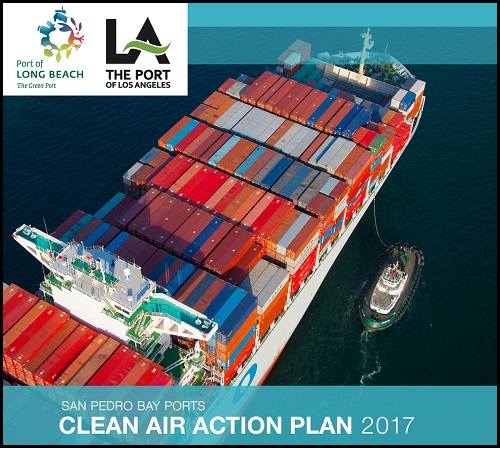
|
|

|
|
| April 16, 2024 |
|
LA, Long Beach ports’ clean up could run into the billions 
SACRAMENTO--Declaring it the largest environmental investment ever undertaken by a cargo complex to wean itself off diesel dependency, Los Angeles and Long Beach port officials unveiled their Clean Air Action Plan update, with a price tag that could reach $14 billion.
The latest installment in a decade-long effort to reduce pollution along the docks, which has already drastically reduced the toxic soup around the mammoth complex, aims to replace dirty-burning trucks and cargo-handling equipment with gear that produces zero, or almost zero, emissions. Officials didn’t soft-sell the price, acknowledging that it will place “an enormous financial burden on the ports and goods-movement industry,” even if government helps foot the bill. CAAP is the heart of the joint vow made by Los Angeles Mayor Eric Garcetti and Long Beach Mayor Robert Garcia to make the nation’s busiest port complex a nearly no-pollutant zone by 2035. If the promise is kept, the project will eliminate the region’s largest stationary source of pollution. Diesel emissions have been linked to higher rates of asthma and respiratory problems in communities around the ports, and Gov. Jerry Brown has staked his legacy on fighting climate control in the state. Here’s how the long-awaited plan aims to work: The strategy at a glance • The bottom line: CAAP would convert the port’s huge truck fleet from diesel to zero-emission fuels, develop and deploy green-burning gear to load and unload ships and assertively grow pollution-cutting programs for port-run vessels and other ships. • The timetable: Last fall’s draft version was broadly scrutinized and subsequently revised — and more review will come quickly. Los Angeles and Long Beach harbor commissions must approve the plan — and a vote is expected in November. • How you can get involved: A new public comment period for the plan extends through Sept. 18 and officials will be holding a public workshop on Aug. 30 at Banning’s Landing Community Center. For more info: www.cleanairactionplan.org. The price – and how to pay it • The bottom line: Between $7 and $14 billion will be spent to rid the ports of machines now powered by fossil fuels. • The breakdown: As much as $8.2 billion will be spent to deploy zero-emissions big-rigs — and another $1.03 bullion to deploy near-zero emissions vehicles. • Cargo handling: Green-burning equipment will cost as much as $8.2 billion. The infrastructure to support it? Another $2.2 billion. • At berth: As much as $138 million will be spent to reduce emissions where ships are moored. • Ships: As much as $137 million would pay for incentive programs to reduce emissions produced by cargo craft visiting the ports. • R&D: $22 million would fund research, development and demonstration of new gear. • Who pays for it? Starting now, port officials are looking for support from the state and federal government. Brown and the Democrat-dominated legislature are likely proponents. But the reception from Washington D.C. is likely to be a lot chillier. With Donald Trump in the White House, California can no longer rely on the administration for rubber-stamped support of its environmental goals. Regardless, the plan makes it clear: “Outside of any state and federal funding ... these costs will be borne by the ports themselves and private industry.” • How fast? Officials will need much of the funding within five to seven years to ensure there is the infrastructure in place to convert to zero emissions beyond that time. The response • From the ports: “A major part of our success is going to be getting as much funding as we can to support this transition,” said Long Beach’s Tomley, who helped put together the plan. • From shippers: “The CAAP puts all its eggs in one basket by unrealistically assuming that non-existent, non-automated, zero-emissions electric cargo handling equipment technology will be developed, tested, work as planned and be affordably mass produced to meet the ports’ rigid timelines,” John Mclauren, president of the Pacific Merchant Shipping Association said in a released statement. “That’s a pretty big assumption with no margin for error and no Plan B if and when something goes wrong.” • From the trucking industry: “It is important to set goals that are reasonable and attainable, and that we don’t saddle an industry that has invested billions of dollars in clean technology with a mandate that is not viable commercially or operationally,” said Weston LaBar, Executive Director of the Harbor Trucking Association. “There are still many questions regarding zero emissions truck technology. It is important that the ports insure the final plan paves a path forward for affordable and efficient movement of cargo through the San Pedro Bay Complex first, and that sustainability is a by-product of a healthy supply-chain in the region.” (Source: Los Angeles Daily News) Story Date: July 24, 2017
|